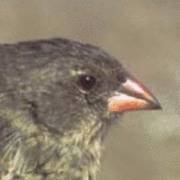Detlef spoke at Kinderuni
Covered in our local newspaper
Tübingen Children’s University
Max Planck researcher Detlef Weigel at the Children’s University: Big beak on demand
Max Planck researcher Detlef Weigel talked about dogs, finches and the four letters of life.
29.06.2022
By Ulla Steuernagel
Watching evolution at work takes time. At the Tübingen Children’s University, it went a little faster. On Tuesday, biology professor Detlef Weigel explained to the young students how biodiversity develops and why a sheepdog is a sheepdog and not a dachshund. About 180 young and old listeners followed the lecture of the renowned and award-winning plant geneticist in the Kupferbau lecture hall.
When most people think of evolution, they think of dinosaurs. After all, they are considered the losers of evolution, having become extinct about 60 million years ago. Or are there still relatives, Weigel asked the children. And they knew that lizards and crocodiles are indeed related to the dinos, and birds even their descendants.
As an evolutionary scientist, you’re dealing with very large periods of time and tiny little changes. But sometimes change can happen quickly and be highly visible. Here, “Sam” took the lecture hall stage, a mongrel of Australian shepherd and poodle. This friendly-looking animal with fuzzy fur and floppy ears could no longer be seen that dogs originally descended from wolves. With dogs, breeders mixed and mix, depending on the speed of long legs (sheepdog) or assistance in hunting (dachshund).
However, the development of living creatures usually happens entirely without human intervention. Nature creates the diversity and adapts the species to the environmental conditions. Even Charles Darwin, who was born more than two hundred years ago, observed how the beaks of finches on the Galapagos Islands changed depending on which seeds they had to pick.
However, the research couple Rosemary and Peter Grant found out long after him that large beaks were not advantageous for all times. Beaks evolved according to the weather and the size of the seeds. “Evolution,” the professor said, “doesn’t just go in one direction.” The causes of such changes play out entirely in secret: in the tiny nucleus of each cell. This is where the genetic material, the genes, sit. “Not everything is inherited,” Weigel explained. No matter how much the parents go to the gym – the muscles trained here do not transfer to the next generation.
Genes are part of DNA (the deoxyribonucleic acid or English: acid for acid), two spiral-shaped strands. DNA is composed of four elements, each designated by a letter: A, T, G, C. These elements cannot combine at will: G can only combine with C, A can only combine with T, and vice versa. The DNA also does not always remain the same: “Mutations, i.e. changes, occur all the time,” says Weigel. If something goes wrong, the body can often repair it itself, but not always. For example, you can get sick from too much exposure to the sun.
Incidentally, the DNA was discovered in Tübingen. Weigel recommended taking a look at Friedrich Miescher’s laboratory in the castle. And as far as evolution is concerned, Weigel summarized for the children: It creates changes in genes, it can be fast or slow, it doesn’t run in just one direction, and it always takes place.
Wikipedia is often a good source
For his lecture, Detlef Weigel revealed, he had to look up some things, and he did so in a place that tends to be frowned upon in schools: “I find Wikipedia quite a good source,” Weigel said. His real area of research is not dogs, but inconspicuous plants. The thale cress (scientific name: Arabidopsis) is very suitable for evolutionary observers; it reproduces quickly and is extremely adaptable, coping with a wide variety of climates in Europe, as well as in Asia, Africa and even Patagonia, just outside the South Pole. It is not obvious that it is also related to wild cabbage, which in turn was once related to wild mustard. But that was a while ago: “Ten million years,” said Weigel.

Detlef Weigel with Sam, a family-friendly mix of Australian Shepherd dog and poodle. Picture: Ulrich Metz


